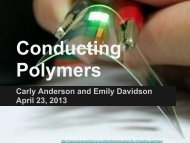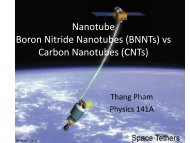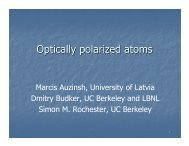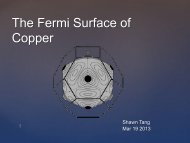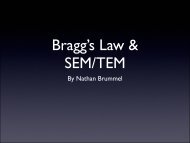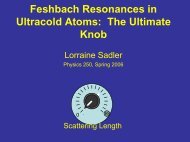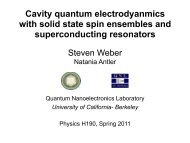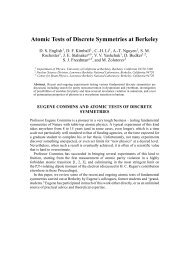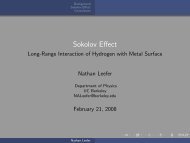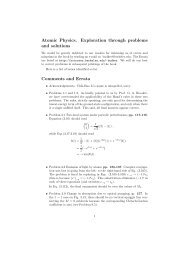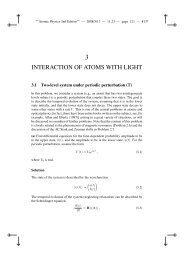Resonant nonlinear magneto-optical effects in atomsâ - The Budker ...
Resonant nonlinear magneto-optical effects in atomsâ - The Budker ...
Resonant nonlinear magneto-optical effects in atomsâ - The Budker ...
You also want an ePaper? Increase the reach of your titles
YUMPU automatically turns print PDFs into web optimized ePapers that Google loves.
27<br />
separation, as anticipated, but signal quality was strongly<br />
degraded as L <strong>in</strong>creased (Mlynek et al., 1987). 27<br />
<strong>The</strong> first beam experiment with a long (34.5-cm)<br />
precession region was done by <strong>The</strong>obald et al. (1991)<br />
us<strong>in</strong>g D2-l<strong>in</strong>e excitation on a Cs beam with fluorescence<br />
detection. In similar work, us<strong>in</strong>g detection of<br />
forward-scattered light rather than fluorescence monitor<strong>in</strong>g,<br />
Schuh et al. (1993); Weis et al. (1993b) applied<br />
pump-probe spectroscopy to a Rb beam us<strong>in</strong>g D2-l<strong>in</strong>e<br />
excitation. Two experiments were performed with <strong>in</strong>teraction<br />
lengths of L = 5 cm (Schuh et al., 1993) and<br />
L = 30 cm (Weis et al., 1993b), respectively. Improv<strong>in</strong>g<br />
the sensitivity by go<strong>in</strong>g to longer <strong>in</strong>teraction lengths is<br />
difficult because of signal loss due to the f<strong>in</strong>ite atomicbeam<br />
divergence. This can be counteracted by laser collimation<br />
of the beam (this technique is be<strong>in</strong>g used <strong>in</strong><br />
work towards a 2-m apparatus at U. Fribourg), or by<br />
us<strong>in</strong>g atoms that are free-fall<strong>in</strong>g from a <strong>magneto</strong>-<strong>optical</strong><br />
trap or an atomic founta<strong>in</strong> (Sec. VIII.H). Hypersonic<br />
and laser-slowed beams can also be used to <strong>in</strong>crease the<br />
atomic flux and transit time, respectively.<br />
F (arb. units)<br />
<br />
<br />
<br />
<br />
<br />
<br />
<br />
<br />
<br />
B (mG)<br />
FIG. 16 Experimental Faraday-Ramsey signal from a thermal<br />
Cs beam (T = 400 K) and a precession length of L = 30 cm.<br />
Polarimetric detection of the rotation angle ϕ of the probe<br />
beam is used.<br />
2. L<strong>in</strong>e shape, applications<br />
In Faraday-Ramsey spectroscopy, one measures the<br />
<strong>magneto</strong>-<strong>optical</strong> rotation angle ϕ of the l<strong>in</strong>early polarized<br />
probe beam. For a beam with Maxwellian velocity<br />
distribution, the magnetic-field dependence of ϕ is obta<strong>in</strong>ed<br />
from the three-step model discussed <strong>in</strong> Sec. V.B<br />
<strong>in</strong> a manner similar to that described <strong>in</strong> Sec. VII.A:<br />
ϕ(B) ∝<br />
∫ ∞<br />
0<br />
( B<br />
s<strong>in</strong><br />
B0<br />
R<br />
1<br />
u + 2θ pp<br />
)<br />
u 2 e −u2 du. (26)<br />
where θ pp is the relative orientation of the pump and<br />
probe polarizations, u = v/v 0 is the dimensionless velocity,<br />
and v 0 is the most probable velocity <strong>in</strong> the atomic<br />
beam oven, and<br />
B R 0 = ¯hv 0<br />
2gµL<br />
(27)<br />
is a scal<strong>in</strong>g field (L is the distance between pump and<br />
probe beams). <strong>The</strong> l<strong>in</strong>e shape is a damped oscillatory<br />
Ramsey fr<strong>in</strong>ge pattern centered at B = 0 (the scal<strong>in</strong>g<br />
field B0 R is a measure of the fr<strong>in</strong>ge width). Figure<br />
27 Other examples of early work <strong>in</strong> the field are the work of Bertucceli<br />
et al. (1986), who used fluorescence detection to observe <strong>nonl<strong>in</strong>ear</strong><br />
level-cross<strong>in</strong>g Ramsey fr<strong>in</strong>ges <strong>in</strong> a metastable Ca beam, the<br />
work of Nakayama et al. (1980), who observed Ramsey fr<strong>in</strong>ges<br />
on the D1 l<strong>in</strong>e <strong>in</strong> a Na vapor cell us<strong>in</strong>g laser beams separated<br />
by up to 10 mm, and an experiment performed by Borghs et al.<br />
(1984) <strong>in</strong> the time doma<strong>in</strong> us<strong>in</strong>g a monok<strong>in</strong>etic Ba + beam, which<br />
showed a large number of higher-order fr<strong>in</strong>ges, normally damped<br />
<strong>in</strong> thermal beams due to the large velocity spread. This last experiment<br />
determ<strong>in</strong>ed the ratio of g-factors of the 5d 2 D 3/2 and<br />
5d 2 D 5/2 states of Ba + .<br />
VIII.C.2 shows an experimental Faraday-Ramsey spectrum<br />
recorded with a thermal Cs beam (T = 400 K) with<br />
a precession region of L = 30 cm, for which B0<br />
R = 170 µG.<br />
Faraday-Ramsey spectroscopy has proven to be an extremely<br />
sensitive tool for <strong>in</strong>vestigat<strong>in</strong>g sp<strong>in</strong>-coherence<br />
perturbations by magnetic and/or electric 28 fields under<br />
collision-free conditions. Any additional external perturbation<br />
which affects sp<strong>in</strong> coherence will lead to an additional<br />
phase shift <strong>in</strong> the fr<strong>in</strong>ge pattern given by Eq.<br />
(26). Faraday-Ramsey spectroscopy has been applied <strong>in</strong><br />
a variety of situations, <strong>in</strong>clud<strong>in</strong>g an <strong>in</strong>vestigation of the<br />
Aharonov-Casher effect <strong>in</strong> atoms (Sec. XII.C), a precision<br />
electric field calibration (Rasbach et al., 2001), and<br />
a measurement of the forbidden electric tensor polarizabilities<br />
(Sec. XII.D) of the ground state of Cs (Rasbach<br />
et al., 2001; Weis, 2001). Applications of the technique<br />
of Faraday-Ramsey spectroscopy with atomic beams to<br />
the search for parity- and time-reversal-<strong>in</strong>variance violation,<br />
<strong>in</strong> particular, for a permanent electric dipole moment<br />
(EDM, Sec. XII.B) have also been discussed (Schuh<br />
et al., 1993; Weis et al., 1993b). Note, however, that<br />
a competitive EDM experiment would need a very <strong>in</strong>tense<br />
<strong>optical</strong>ly thick atomic beam, such as the source<br />
built for experiments with atomic thallium by DeMille<br />
et al. (1994).<br />
28 Electric <strong>in</strong>teractions do not couple to sp<strong>in</strong> directly; however, they<br />
affect the orbital angular momentum. Thus sp<strong>in</strong> coherences are<br />
affected by an electric field via sp<strong>in</strong>-orbit and hyperf<strong>in</strong>e <strong>in</strong>teractions.



